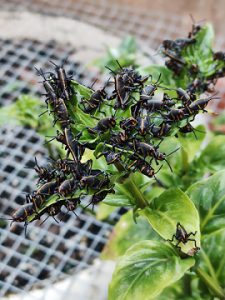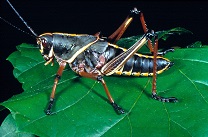I was recently startled in my garden by some black tips on one of my edible plants.

Upon closer inspection, I discovered that the whole tip of the two tallest stems were covered in small, black grasshoppers. I estimate there were as many as 40 individual insects. Having helped my children to collect insects for a 4-H Entomology project years ago, I immediately knew what these were: “Lubbers”.
In Florida, we gardeners have many insect pests with which to contend. At almost 4-inches long, the Eastern Lubber Grasshopper is probably the largest pestiferous character we deal with. In its adult life-stage, “Lubbers” are colorfully marked with yellow, green, orange, black, and red. You can sometimes hear them clicking as they move about the foliage. They are slow moving creatures, easy to capture in a clean, wide-mouth peanut butter jar.
Manual Pest Control vs. Chemical Pest Control
This past summer, over the course of one week, I managed to contain 15 adult lubbers. I’d found them munching on my crinum lilies during my morning walk through the landscape. I even captured a mating pair, hoping to stop the damage to my landscape before they laid their eggs. So far it has been a successful effort with no new damage to the crinums.
However, as of March 7th, 2023, I have found 6 separate hatching sites of these pests in my small backyard garden. But these hatchlings bear almost no resemblance to their adult parents. The newly hatched Eastern Lubber Grasshopper is 1 centimeter long and almost entirely black, with a long, yellow dorsal stripe. When newly emerged from under the soil’s surface, they climb up the nearest tall object or stem and congregate at the top. There can be anywhere from 20 to 80 individual grasshoppers.

The Timing
This time of year, a warm spring, is when I like to scout for pests as I go about my daily garden chores of watering and weeding. I collect as many lubber nymphs as I can to dispatch them in the freezer. Stomping around on them is also an efficient way to control their population in my landscape. I don’t like to use chemical controls in my edible plant beds.
According to the University of Florida’s IFAS (Institute of Food and Agricultural Sciences) Electronic Data Information Source (EDIS) publication on Lubbers, the best way to control Eastern Lubber Grasshopper is by hand picking them off plants. This is called manual control, and it is not for the squeamish gardener. The freezer is my preferred method of pest death because it involves no extra chemical output and no mess. The adult female lubber can be as much as 4-inches long and makes a bit of a smear when squished.
Another Manual Control Method
Quite a few insect pests I find I can feed to my chickens- hornworms, beetles, ants, flies, caterpillars, and grubs. But not the Lubber. Their body contains a toxin which may be fatal to birds.
Learn More
To learn more about the Eastern Lubber Grasshopper, the UF/IFAS EDIS publication “Eastern Lubber Grasshopper, Romalea microptera…” is interesting reading. This publication includes a list of insecticides which might control the young nymphs and an interesting history of the name choice, “Lubber”, for these creatures.
If you would like to read about some other Florida grasshoppers, “Common Grasshoppers in Florida”, is another great UF/IFAS EDIS publication.
 1
1
